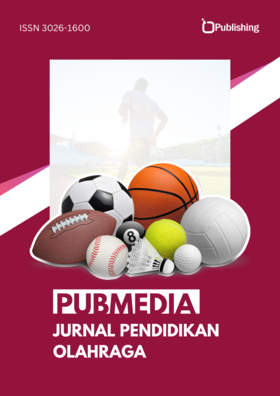The Effect of Educational Units According to the Cognitive Training Strategy on Cognitive Flexibility and Learning the Skill of Scoring in Football
DOI:
https://doi.org/10.47134/jpo.v1i3.383Keywords:
Cognitive Training Strategy, Cognitive Flexibility, Learning OutcomesAbstract
The first chapter contained the introduction and importance of the research, as the importance of using the cognitive training strategy according to cognitive flexibility was addressed for learning football for first-stage students. The research aims to address whether educational units developed by the researchers positively influence learning outcomes in football scoring. The objectives of the research were to prepare educational units using a cognitive training strategy according to cognitive flexibility in learning the skill of scoring in football. Where the research areas were: The human field: first-year students in the College of Basic Education, Department of Physical Education and Sports Sciences / Al- Mustansiriya University, the time field: for the period from 10/12/2022 until 2/ 10/2023. As for the research community, it was represented by the students of the first stage in the College of Basic Education/Al- Mustansiriya University (70) students. The sample consisted of two equal groups (10), experimental and control. The Vina system was used using a three-dimensional test to determine cognitive flexibility. The researcher conducted pre-tests for the research sample, then the main experiment was applied for a period of 10 weeks, one educational unit per week, after which the researcher conducted the post-tests and the pre-tests with the same procedures, which indicated that there were significant differences between the two research groups and in favor of the experimental group. The conclusions were that there was a positive impact of the educational units used in the research to learn skills, as the researcher recommended using a cognitive training strategy according to cognitive flexibility in learning other skills.
References
Abd Zaid, I., & Al-Nuaimi, A. H. (2021). Designing Constructive Educational Units in Physical Education. Jordan: Dar Al-Wefaq.
Aldawsari, H. K. (2023). Developing Productive Thinking Skills in the field of Artistic Works using the SCAMPER Strategy for Twice Exceptional Students. International Journal of Learning, Teaching and Educational Research, 22(12), 1–20. https://doi.org/10.26803/ijlter.22.12.1 DOI: https://doi.org/10.26803/ijlter.22.12.1
Al-Jabri, K. K. R. (2011). Research Methods in Education and Psychology (1st ed.). Baghdad.
Al-Ridi, K. J. (2001). Sports Training for the Twenty-First Century (1st ed.). Amman: Dar Al-Nour Distribution.
Alwan, B. (2002). The effect of mastery learning on the acquisition and retention of some basic volleyball skills (Doctoral thesis). University of Baghdad, College of Physical Education.
Buckthorpe, M. (2019). Recommendations for hamstring injury prevention in elite football: Translating research into practice. British Journal of Sports Medicine, 53(7), 449–456. https://doi.org/10.1136/bjsports-2018-099616 DOI: https://doi.org/10.1136/bjsports-2018-099616
Cheng, M. M. H. (2020). Implementing practitioner research as a teacher professional development strategy in an Asia-Pacific context. Journal of Education for Teaching, 46(1), 55–70. https://doi.org/10.1080/02607476.2019.1708627 DOI: https://doi.org/10.1080/02607476.2019.1708627
de la Cruz, J. A. (2023). Impact of a mathematics early teaching experience for undergraduates: A teacher preparation recruitment strategy. International Electronic Journal of Mathematics Education, 18(4). https://doi.org/10.29333/iejme/13860 DOI: https://doi.org/10.29333/iejme/13860
Farhan Ali, A. (2015). Basics of scientific research and statistics in physical education. Najaf: Dar Al-Diyaa Printing.
Hammad, M. I. (2007). What is new in the physical, skill and tactical preparation of the football player. Cairo: Dar Al-Fikr Al-Arabi.
Isa, N. K. M. (2021). Teaching and facilitation implementation methods among lecturers and their influence on students’ interests in learning geography. Journal of Language and Linguistic Studies, 17(3), 1325–1340. https://doi.org/10.52462/jlls.95 DOI: https://doi.org/10.52462/jlls.95
Ismail, A., et al. (2019). What is new in educational design and educational technology. Baghdad: Forum Press.
Klingenberg, S. (2020). Investigating the effect of teaching as a generative learning strategy when learning through desktop and immersive VR: A media and methods experiment. British Journal of Educational Technology, 51(6), 2115–2138. https://doi.org/10.1111/bjet.13029 DOI: https://doi.org/10.1111/bjet.13029
Komar, S. (2019). The challenges, methods and results of teaching GB pronunciation to slovene EFL students. ELOPE: English Language Overseas Perspectives and Enquiries, 16(1), 101–122. https://doi.org/10.4312/elope.16.1.101-122 DOI: https://doi.org/10.4312/elope.16.1.101-122
López-Valenciano, A. (2020). Epidemiology of injuries in professional football: A systematic review and meta-analysis. British Journal of Sports Medicine, 54(12), 711–718. https://doi.org/10.1136/bjsports-2018-099577 DOI: https://doi.org/10.1136/bjsports-2018-099577
López-Valenciano, A. (2021). Injury Profile in Women’s Football: A Systematic Review and Meta-Analysis. Sports Medicine, 51(3), 423–442. https://doi.org/10.1007/s40279-020-01401-w DOI: https://doi.org/10.1007/s40279-020-01401-w
Ogunniyi, S. O. (2020). Teaching Methods and The Utilization Of The Library Information Resources Among Lecturers In The University Of Medical Sciences In Ondo, Ondo State. Library Philosophy and Practice, 2020, 1–18.
Patton, R. (2023). Socially Engaged Art Practices, Tactical Media, And Games: Methods for Civic Participation in Digital Art Education. Teaching Civic Participation with Digital Media in Art Education: Critical Approaches for Classrooms and Communities, 40–55. https://doi.org/10.4324/9781003402060-5 DOI: https://doi.org/10.4324/9781003402060-5
Qasim, S. S. A. (2017). Differences in strategies for coping with psychological stress in light of both psychological hardiness and cognitive and psychological flexibility among university professors practicing administrative tasks. Journal of Educational and Psychological Studies, Faculty of Soil, Zagazig University, (96).
Ray, A. B. (2022). Practice-Based Professional Development for Self-Regulated Strategy Development Writing Instruction With Secondary Teachers. Teaching Exceptional Children. https://doi.org/10.1177/00400599221122888 DOI: https://doi.org/10.1177/00400599221122888
Safapour, E. (2019). A review of nontraditional teaching methods: Flipped classroom, gamification, case study, self-learning, and social media. Education Sciences, 9(4). https://doi.org/10.3390/educsci9040273 DOI: https://doi.org/10.3390/educsci9040273
Sardegna, V. G. (2022). Evidence in favor of a strategy-based model for English pronunciation instruction. Language Teaching, 55(3), 363–378. https://doi.org/10.1017/S0261444821000380 DOI: https://doi.org/10.1017/S0261444821000380
Shaker, N. M. (2014). Movement Sciences. Iraq: Diyala University, Central Press.
Shalash, N. M., & Abdul Hadi, M. (2010). Principles of Motor Learning (2nd ed.). Najaf: Dar Al-Diyaa Printing.
Susilowati, Y. (2020). The relationship between students, attitudes toward lecturer teaching methods and learning environment with achievement motivation (descriptive study of management students of Stie Dharma Agung). Universal Journal of Educational Research, 8(3), 65–71. https://doi.org/10.13189/ujer.2020.081409 DOI: https://doi.org/10.13189/ujer.2020.081409
Vizcaya-Moreno, M. F. (2020). Social media used and teaching methods preferred by generation z students in the nursing clinical learning environment: A cross-sectional research study. International Journal of Environmental Research and Public Health, 17(21), 1–10. https://doi.org/10.3390/ijerph17218267 DOI: https://doi.org/10.3390/ijerph17218267
Younis, M. (2010). History of Education, Educational Thought. Riyadh: Al-Rasheed.
Zhang, X. (2021). Teachers’ adoption of an open and interactive e-book for teaching K-12 students Artificial Intelligence: a mixed methods inquiry. Smart Learning Environments, 8(1). https://doi.org/10.1186/s40561-021-00176-5 DOI: https://doi.org/10.1186/s40561-021-00176-5
Downloads
Published
How to Cite
Issue
Section
License
Copyright (c) 2024 Muneeb Hassan Nashmi, Abdul Rahman Nasser Rashid, Adel Abbas Dhiyab

This work is licensed under a Creative Commons Attribution 4.0 International License.










